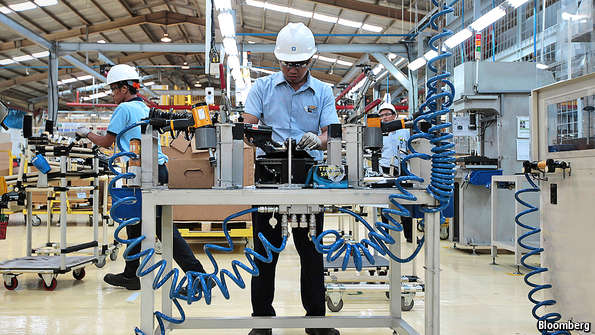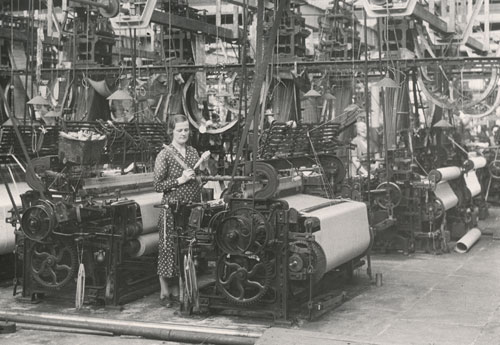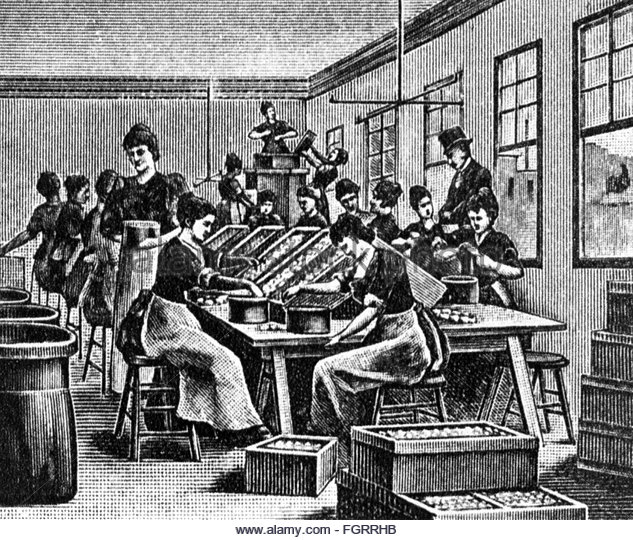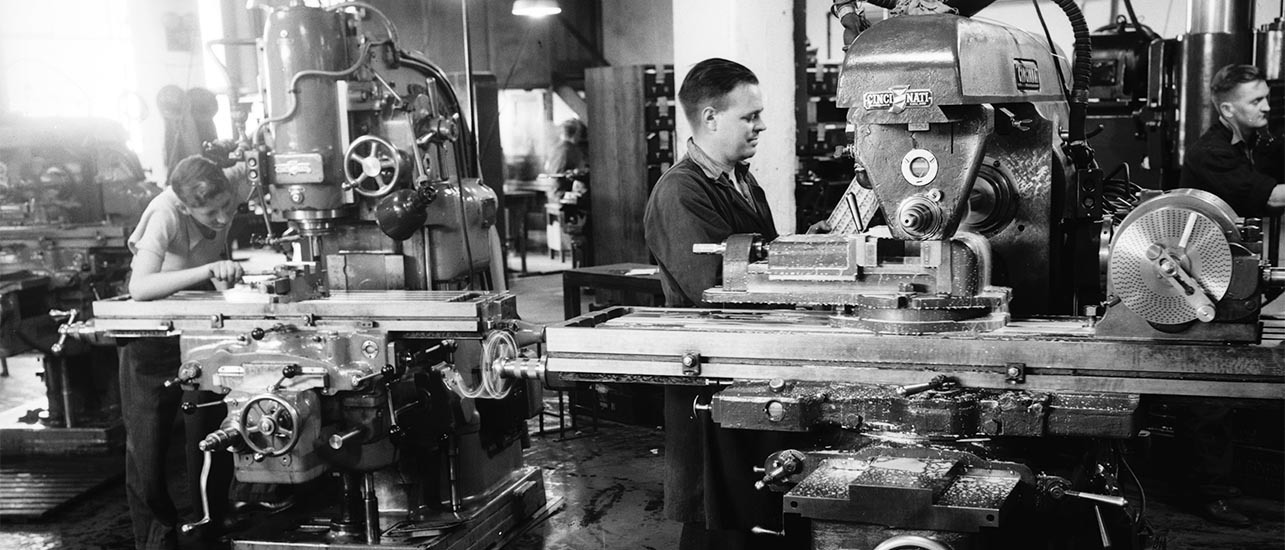The History of Canadian Manufacturing
Manufacturing
Manufacturing is a critical component of Canada’s economy. The production, sale and distribution of finished products contribute to consumer and labour markets, and secure Canada’s position as an economic leader among developed nations.

Manufacturing is a critical component of Canada’s economy. The production, sale and distribution of finished products contribute to consumer and labour markets, and secure Canada’s position as an economic leader among developed nations. Major, medium-sized and small manufacturers produce goods used by Canadians and contribute to the revenue gained from the export of goods to other countries. Since the early 2000s, the manufacturing sector in Canada has declined significantly in response to changes in the global economy and fewer regulatory controls over Canadian products. The composition and structure of the Canadian manufacturing industry is transitioning in response to these changes, aiming to produce new goods that are in greater demand.
Description
The manufacturing industry produces a broad range of products for an equally broad range of uses. For example, manufacturing provides equipment for exploring, developing, extracting, processing and distributing resources from land, oceans and forests. Equipment for these purposes may include hydroelectric generators, fishing vessels, railway locomotives, farm machinery, mining equipment and machinery for transforming oil, natural gas and coal into chemicals, textiles and paints. Durable goods — including refrigerators, automobiles and telephones — are manufactured for such purposes as housing, transportation and communications. Manufactured edible goods include beverages, dairy products, processed vegetables and meat. Finally, manufacturing also includes machinery and equipment to package, handle, distribute, store and record all other manufactured goods.
Manufacturing is a major purchaser of raw materials and services. For example, steel is manufactured from iron ore, coal and other materials, which are mined and transported by railways, ships, trucks and conveyors (all manufactured goods). Executives, salespeople, engineers and others in the steel companies use all modes of transportation and types of accommodation, and purchase many services (e.g., data processing, communications, legal, accounting).
History
Eighteenth Century

Manufacturing in Canada began early in the 18th century with the introduction of gristmills to process grains into flour. The first gristmills were built in New France in the 17th century and, by 1840, there were 400 in Upper Canada and Lower Canada producing flour for domestic and foreign markets. Iron smelting began in the 1730s at the Forges St-Maurice near Trois-Rivières, Québec. By the mid-1740s, this foundry supplied some of New France's armament requirements as well as stoves and household utensils. The first steamboat made in Canada, the accommodation, was built in 1809 by the Eagle Foundry of Montréal, which made all of the more than 100 parts for its engines. The engines of the Royal William, which was, in 1833, the first ship to cross the Atlantic almost continuously under steam power, were manufactured by St Mary's Foundry in Montréal.
Nineteenth Century

Several events in the last half of the 19th century stimulated substantial growth in Canada's manufacturing industries. The first was Confederation in 1867. With political unification and self-government came geographic expansion, construction of the Canadian Pacific Railway, and new settlement bringing population increases, skills and capital. In 1871 a group of businessmen founded the Canadian Manufacturers' Association (CMA) dedicated to promoting the growth of manufacturing. Eight years later, John A. Macdonald's National Policy established protective tariffs to encourage domestic processing of Canadian materials. Newly established factories processing products for domestic consumption (such as lumber, grains and animal products) survived and prospered even during the economic depression of the late 1870s and early 1880s.The discovery of electricity and the subsequent harnessing of some of Canada's vast hydro resources provided industry with an efficient, low-cost source of electrical energy (see hydroelectricity). At the same time, the extent of the mineral wealth beneath the Canadian Shield began to be realized, stimulating great interest in Canada's growth potential. The First World War stimulated industrial development and diversification, especially in such industries as steel, shipbuilding, nonferrous metals, and pulp and paper.
By 1920 manufacturing directly employed 600,000 workers, about 17 per cent of the total labour force at that time. The worldwide depression of the 1930s reduced economic activity and stifled industrial progress in Canada as in other countries, but Canadian industry expanded and diversified dramatically during the Second World War. There was swift growth in heavy industries (vehicles, aircraft, armaments, shipbuilding and steel) and spectacular development in aluminum, electrical apparatuses, communications equipment, tool making and chemicals. By the mid-1940s, manufacturing directly employed over one million workers, more than 25 per cent of the labour force.
Twentieth Century

Throughout the 20th century, manufacturing contributed significantly to the economic well-being and prosperity of Canadians. Between 1945 and 1999, manufacturing accounted for a high of 24 per cent and a low of 15 per cent of Canada's total real output of goods and services, or Gross Domestic Product. By 1999, manufacturing accounted for approximately 19 per cent of Canada’s Gross Domestic Product, and 1.9 million jobs. In this period Canada's manufacturing industry was strongly affected by computer technology, energy-price escalation and trade liberalization.
The first industrial computer was introduced in Canada in 1957. Since then, computer technology has found widespread use in manufacturing for tasks such as production, inventory control and accounting. The use of computer-aided design (CAD), computer-aided manufacturing (CAM) and robotics technologies has increased rapidly. Electronics spurred the explosive growth of Canada's telecommunications industry, which reached worldwide stature by the 1980s. Canadian manufacturers participated in the Aerospace industry by designing and producing communication satellites, and components for spacecraft and aircraft (see Space Technology).
The rapid rise in world oil prices in the 1970s had a stimulating effect on the development of Canada's energy resources, particularly from bitumen in Alberta’s oil sands region as well as from natural gas, coal seams, hydroelectric dams and uranium deposits. Demand increased for machinery and equipment used in exploring, developing and distributing these energy resources. Increased supply of energy permitted Canadian manufacturers to achieve internationally competitive scales of operation. Canadian-manufactured machinery and equipment have been used in energy development and production throughout the world.
In the second half of the 20th century, four key developments in trade policies and practices significantly affected Canadian manufacturers. They included: the Canada-US Automotive Products Agreement (or “Autopact”); the General Agreement on Tariffs and Trade (GATT); globalization of production; and multilateral Free Trade agreements reached with the US in late 1987 (Free Trade Agreement or FTA) and its expansion in 1994 to include Mexico (North American Free Trade Agreement or NAFTA). The 1965 Canada-US Automotive Products Agreement (known as the Autopact) between Canada and the US created a conditional, duty-free environment which has allowed the Canadian and US industries to rationalize according to appropriate economies of scale, resulting in efficient industries that serve an integrated Canada-US market. The Autopact benefited both countries at different times. Canada gained substantially more production, an increase in trade and productivity, a greater share of North American automotive employment and lower consumer prices.
Canada was one of 23 major trading nations that signed the original GATT treaty in 1947. GATT was a multilateral agreement signed by 85 nations and 30 provisional signees; its rules called for the elimination of discriminatory treatment in international commerce in order to maximize the use of world resources and thereby raise living standards. GATT membership was part of a national commitment to the principle of "freer trade," which over time increased the volume of manufactured goods to Canada. There have been nine rounds of GATT negotiations, the first in 1947 and the most recent in 2001 (the negotiations for which are still underway). The GATT was replaced in 1995 with the establishment of the World Trade Organization following negotiations conducted during the 1986 round of negotiations. The World Trade Organization assumed responsibility for the administration of multilateral trade agreements formerly conducted under GATT.
The state of international competition has changed drastically since the late 1950s and early 1960s. At that time, Europe and Japan were largely preoccupied with postwar rebuilding and with the development of internal markets. Canada's share of the world's exports of manufactured goods rose from 4.5 per cent to 6 per cent only to fall back to 4.5 per cent by the end of the 20th century. The emergence of Japan, Europe and China as global industrial powers has meant tougher competition for Canadian manufacturers. Competition has been increasingly based on cost of production per unit, placing downward pressure on wages and other costs associated with the production and transportation of manufactured goods. There has been intensified competition in the domestic and international markets in nearly all sectors, but particularly automobile production, machinery and electronics. Industrialization among lesser developed countries, due largely to the influence of foreign-direct investment associated with globalization, has focused on sectors producing labour-intensive, low-technology, highly-transportable goods. Increasing imports from lesser developed countries has created significant problems in Canada in such sectors as clothing, certain textiles, the lower range of the footwear market and consumer electrical products, as competition has become increasingly globalized.
Twenty-first Century
Economic and regulatory changes affecting Canadian manufacturing in the last quarter of the 20th century further intensified in the 21st century. By the 2000s, the manufacturing sector had declined significantly. Between 2004 and 2008, about one in seven (or 322,000) manufacturing jobs had disappeared. This trend is not unique to Canada: the majority of Organisation for Economic Co-operation and Development (OECD) member countries are experiencing a similar decline. Contributing factors include production moving to countries such as China, an aging population (leading to an increased demand for services over manufactured goods) and tariff reduction.
With the exception of the production of transportation equipment (excluding automobiles), oil and coal products, and computers and electronics, all other segments of manufacturing have experienced a downturn. The textile industry, historically one of the largest manufacturing employers in the country, is one of the hardest sectors hit. For example, between 2004 and 2011, jobs at textile mills decreased by over 60 per cent. The automotive sectors, as well as lumber and paper industries, are also in rapid decline, particularly after the 2008 recession.
In response to these changes, Canadian manufacturers are increasingly focused on production for domestic markets as globalized manufacturing and distribution networks undermine production for export. Central Canada continues to dominate the bulk of manufacturing output, with Ontario representing approximately 46 per cent and Québec approximately 24 per cent of total manufacturing sales. Many consumer goods industries are concentrated in these two provinces, which have well over half the country's population.
Found on thecanadianencyclopedia.com
Article by Laurent J. Thibault
